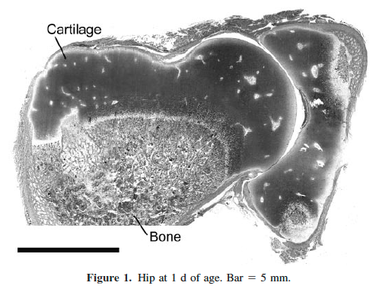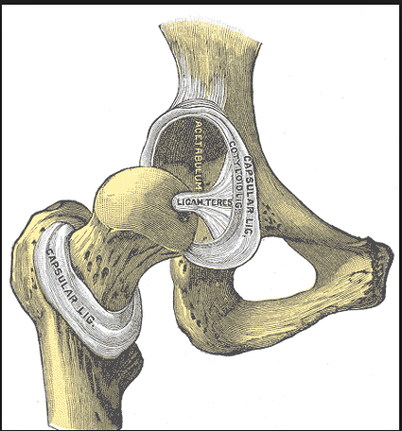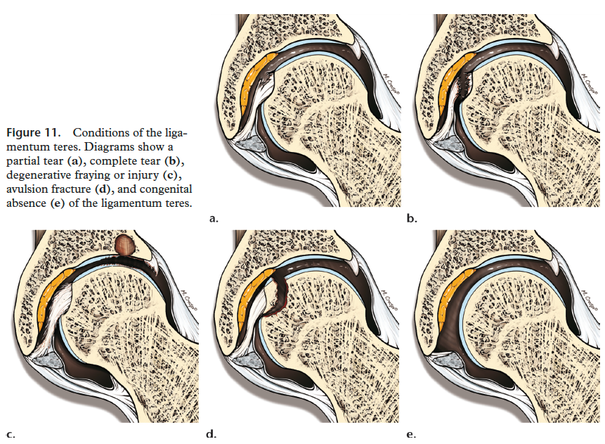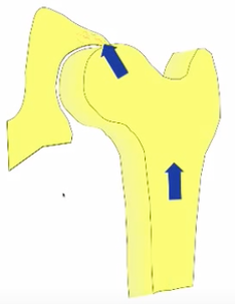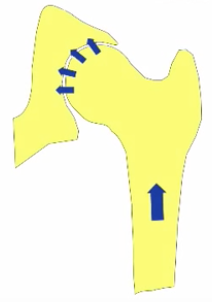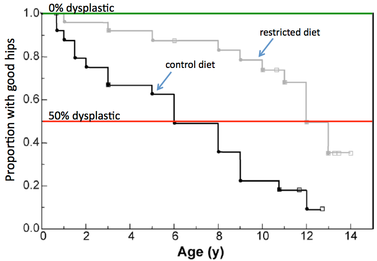This is a great article well written and easily understood that can help owners and breeders to understand some of the major causes and intervention to prevent or reduce the occurrence of canine hip dysplasia.
By Carol Beuchat PhD
Hip dysplasia is a hot topic in dogs, if it's possible to stay "hot" for 50 years. Researchers have been working hard for decades
looking for solutions, and breeders have been doing their best to reduce the risk of producing affected puppies.
But still the problem remains.
There are some simple things we could do to reduce the incidence of hip dysplasia now if we understand a few basic things.
Here are the 10 most important things you need to know.
1) All puppies are born with perfect hips
Hip dysplasia is not a congenital defect; it is not present at birth. Multiple studies have demonstrated that all normal puppies are born
with "perfect" hips; that is, they are "normal" for a newborn with no signs of dysplasia. The structures of the hip joint are cartilage at
birth and only become bone as the puppy grows. If a puppy is going to develop hip dysplasia, the process begins shortly after birth.
2) The genes that cause hip dysplasia remain a mystery
Hip dysplasia tends to be more common in some breeds than others and in some lines than others, which indicates that there is a
genetic component to the disorder. However, scientists have been looking for genes that are responsible for the development of
hip dysplasia in dogs for decades without success.
Genes that are associated with hip dysplasia have been identified in some breeds, but they are breed-specific; that is, the assortment of
genes is different in every breed. (For example, see studies on the German Shepherd dog (Marschall & Distl 2007, Fells & Distl 2014,
and Fels et al 2014), Bernese Mountain Dog (Pfahler & Distl 2012), and Labrador Retriever (Phavaphutanon et al 2008).
Genes that could cause hip dysplasia have not been found in any breed.
It's unlikely that researchers are going to discover an easy genetic solution to the problem of hip dysplasia. It is a complex trait that is
influenced by both genes and environment, and there is no simple solution just over the horizon. We should be able to improve
genetic progress by using selection strategies that are as efficient and effective as possible such as estimated breeding values, EBVs.
One great advantage of using EBVs is that the genes responsible for a trait don't need to be known; you need only a pedigree
database and information about affected animals.
3) Environmental factors are also important
Although there is a genetic influence on hip dysplasia, the heritability of the trait is rather low. Many studies have shown that genetic
variation accounts for only a modest fraction of the variation in hip scores, usually 15-40%. This means that some fraction of the variation
in the quality of the hips is the result of non-genetic, or "environmental" influences. This is one reason why decades of strong selection
has resulted in only modest reductions in hip dysplasia in some breeds. At the current rate of progress and selecting only by phenotype,
it could take decades to achieve a meaningful reduction in the incidence of hip dysplasia (Lewis et al 2013).
Understanding the specific environmental factors that play a role in the development of hip dysplasia should allow us to reduce the number
of animals affected by hip dysplasia even if the genetic basis is not yet understood. This would reduce significant pain and suffering as well
as the expense and heartache endured by owners of an afflicted dog. There is no reason why we should not be taking active steps to do
this now. The top three environmental factors that have been found to play a significant role in the develop of dysplastic hips
are: a) joint laxity, b) weight, and c) exercise (see below).
4) Joint laxity is the primary cause of hip dysplasia
Puppies are born with perfect hips, and if the hips do not develop laxity the dog does not develop hip dysplasia (Riser 1985). Joint laxity
occurs when the head of the femur does not fit snugly into the acetabulum. This could be the result of traumatic injury, overloading of the
joint by weight, lack of muscle strength, or adductor forces (e.g., bringing the legs together). Joint laxity is the primary factor that
predisposes a dog to the development of hip dysplasia.
If this ligament is damaged or severed, the femur will not be held tightly in the socket, which will cause the joint to feel "loose".
If the femoral head is not positioned properly in the socket, the forces on the hip will be abnormal. Instead of being
distributed across the inner surface of the socket, the forces on the joint will be concentrated in a smaller area on the
weaker rim of the acetabulum. The result will be damage to the rim of the socket when a load is placed on the hip joint.
5) Controlling joint stability is key
The teres ligament should hold the head of the femur securely in the socket of the growing puppy while the muscles
that will support the hip develop and grow stronger. But in some puppies, the ligament shows evidence of damage before
they are even a month old (Riser 1985).
"The teres ligaments of the hip joints were edematous [swollen], a few ligament fibers were torn, and capillary hemorrhage
dotted the surface of the ligaments at the point of the tears. These changes were considered the first findings that might be
linked to hip dysplasia."
The abnormal forces on the femur and acetabulum that are caused by joint laxity result in the trauma
that causes hip dysplasia and osteoarthritis of the hip.
"There is no evidence that a primary defect of bone exists but rather the disease is a failure of the muscles and other soft tissues
to hold the hip joint in full congruity. This is further supported by the fact that bony dysplasia can be increased, decreased, or
prevented by controlling the degree of joint instability and incongruity. No other malformations are associated with the disease.
A causal relationship between muscles and soft tissue defects or pathologic changes other than lack of muscle mass or strength
has not been established... Hip dysplasia is a concentration of factors from a pool of genetic weaknesses and environmental
stresses that fall into a programmed pattern of progressive remodeling and degenerative joint disease." (Riser 1985)
6) Body weight is a MAJOR environmental factor
If there is laxity in the hip joint, the amount of damage done to the femur and acetabulum will depend on the magnitude of the
forces in the hip joint. The heavier the dog, the greater the forces will be and also therefore the higher the risk of hip dysplasia
and osteoarthritis.
At four years old, less than 10% of dogs kept on a restricted diet (25% less than the control diet) were dysplastic, while at the same
time more than 30% of the dogs in the control group were dysplastic. As an added advantage, dogs on restricted diets live longer,
too (Kealy et al 2002)!
Unfortunately, many dogs (including show dogs!) are overweight (McGreevy et al 2005, Corbee 2013), and obesity could well be the
single most significant environmental factor affecting the development of hip dysplasia and osteoarthritis. But body weight is a factor
that we can control. Although progress from genetic selection will take many generations, the incidence of hip dysplasia in dogs could be immediately and dramatically reduced simply by practicing better weight management.
7) Exercise is good and bad
Exercise strengthens the muscles of the legs and pelvis, and this will increase the stability of the hip joint.
But all exercise is not created equal.
Puppies raised on slippery surfaces or with access to stairs when they are less than 3 months old have a higher risk of hip dysplasia,while
those who are allowed off-lead exercise on soft, uneven ground (such as in a park) have a lower risk (Krontveit et al 2012). Dogs born in
summer have a lower risk of hip dysplasia, presumably because they have more opportunity for exercise outdoors (Ktontveit et al 2012).
On the other hand, dogs from 12-24 months old that regularly chase a ball or stick thrown by the owner have an higher risk of developing
dysplastic hips (Sallander et al 2006).
The most critical period for proper growth and development of the hip in dogs is from birth to 8 weeks old, so the type of
exercise the puppies are exposed to is most important during this time.
8) Nutrition is important
While puppies are growing rapidly, it is critically important to get their nutrition right.
Growing puppies need to eat enough to support growth but they should not be fat, because any extra weight can increase the risk
of developing hip dysplasia (Hedhammar et al 1975, Kasstrom 1975). An additional problem is that puppies getting too much food could
also consume too much of specific nutrients. Puppies provided a quality commercial puppy food that is fed in the proper amount will have
a nutritionally balanced diet and should not receive any supplements. Dietary supplements, especially of calcium, are not only unnecessary
but could cause serious problems. There is no evidence that supplemental protein or vitamins will reduce the risk of hip dysplasia
(Kealy et al 1991, Nap et al 1991, Richardson & Zentek 1998).
9) Early intervention is critical
Most treatments for hip dysplasia are easier and more successful in younger dogs. If early symptoms are overlooked and screening is
done only after 24 months or more, the window of time with the best prognosis in response to treatment will have passed
(Morgan et al 2000). Signs of lameness usually first appear when the puppy is 4 to 6 months old, but after a month or two the dog
will often seem better. This is because damage to the acetabular rim such as microfractures will have healed and the dog is no longer
in pain, but development of dysplasia and osteoarthritis will continue. From there, the dog might not display clinical signs again for years
while the pathological damage progresses.
Laxity in the joint can be determined as early as 4 months old (either by palpation or PennHIP). If detected early, intervention to
mitigate additional damage can include weight loss, modifying exercise and activities, or surgery - but it must be done early before
skeletal growth is complete. Breeders should educate new puppy owners about the factors that can increase the risk of developing
hip dysplasia and also advise them to get a veterinary examination immediately if there is any sign of lameness.
10) We can dramatically reduce hip dysplasia now
Genetic selection should continue to produce modest progress in the reduction of hip dysplasia. But a significant and immediate
reduction in the number of afflicted animals could be achieved by better control of non-genetic, environmental factors. Weight
management, appropriate exercise, proper nutrition, and early intervention at the first sign of lameness are simple steps we can
take that will dramatically reduce the pain and suffering caused by hip dysplasia. The research will surely continue, but we already
have the information we need to tackle this problem.
Corbee RJ. 2012. Obesity in show dogs. Anim. Physiol. Anim. Nut. DOI: 10.1111/j.1439-0396.2012.01336.x
Fels L, Y Marschall, U Philipp, & O Distl. 2014. Multiple loci associated with canine h.ip dysplasia (CHD) in
German shepherd dogs. Mamm. Genome. DOI 10.1007/s00335-014-9507-1.
Hedhammar A, F-M Wu, L Krook, HF Schryver, A de Lahunta, FP Whalen, FA Kallfelz, EA Nunez, HF Hintz, BE Sheffy,
& GD Ryan. 1975. Overnutrition and skeletal disease: An Experimental Study in Growing Great Dane Dogs. Cornell Vet 64: Supp 5.
Kasstrom H. 1975. Nutrition, weight gain and development of hip dysplasia. An experimental investigation in growing dogs with
special reference to the effect of feeding intensity. Acta Radiol Suppl 344: 135-179.
Kealy RD, DF Lawler, & KL Monti. 1991. Some observations on the dietary Vitamin D requirement of weanling pups. J Nutr
121: S66-S69. Kealy RD, DF Lawler, JM Ballam, SL Mantz, DN Biery, EH Greeley, G Lust, M Segre, GK Smith, & HD Stowe.
2002. Effects of diet restriction on life span and age-related changes in dogs. J. Am. Vet. Med. Assoc. 220: 1315-1320.
Krontveit RI, A Nodtvedt, BK Saevik, E Ropstad, & C Trangerud. 2012. Housing- and exercise-related risk factors associated
with the development of hip dysplasia as determined by radiographic evaluation in a prospective cohort of Newfoundlands, Labrador Retrievers, Leonbergers, and Irish Wolfhounds in Norway. Am J Vet Res 73: 838-846.
Lewis, TW, SC Blott, & JA Woolliams. 2013. Comparative analyses of genetic trends and prospects for selection against hip and
elbow dysplasia in 15 UK dog breeds. BMC Genetics 14:16.
Marschall Y & O Distl. 2007. Mapping quantitative trait loci for canine hip dysplasia in German Shepherd dogs. Mamm. Genpome
18: 861-870. McGreevy, P D, PC Thomson, C Pride, A Fawcett, T Grassi, B Jones. 2005. Prevalence of obesity in dogs examined
by Australian veterinary practices and the risk factors involved. Vet Rec 156, 695-702.
Morgan JP, A Wind, & AP Davidson. 2000. Hereditary bone and joint diseases in the dog. Schlutersche GmbH & Co. KG, Germany.
Nap RC, HAW Hazewinkel, G Voorhout, WE van den Brom, SA Goedegebuure, & AT Kloosteer. 1991. Growth and skeletal development
in Great Dane pups fed different levels of protein intake. J Nutr 121: S107-S113.
Pfahler S & O Distl. 2012. Identification of Quantitative Trait Loci (QTL) for Canine Hip Dysplasia and Canine Elbow Dysplasia in
Bernese Mountain Dogs. PLoS ONE 7(11): e49782. doi:10.1371/journal.pone.0049782
Phavaphutanon J, R.G. Mateescu, K.L. Tsai, P.A. Schweitzer, E.E. Corey, M.A. Vernier-Singer, A.J. Williams,N.L. Dykes, K.E. Murphy,
GLust, R.J. Todhunter. Evaluation of quantitative trait loci for hip dysplasia in Labrador Retrievers. Am. J. Vet. Res. 70: 1094-101.
Richardson DC & J Zentek. 1998. Nutrition and osteochrondrosis. Vet Clinics of N Am: Small Anim Pract 28: 115-135.
Riser WH. 1985. Hip dysplasia. Ch 83 In Textbook of Small Animal Orthopedics. CD Newton & DM Nunamker, eds.
Sallander MH, A Hedhammar, & MEH Trogen. 2006. Diet, Exercise, and Weight as Risk Factors in Hip Dysplasia and Elbow
Arthrosis in Labrador Retrievers. J. Nutr. 136: 2050S-2052S.
Smith, GK, ER Paster, MY Powers, DF Lawler, DN Biery, FS Shofer, PJ McKellvie & RD Kealy. 2006. Lifelong diet restriction
and radiographic evidence of osteoarthritis of the hip joint in dogs. J. Am. Vet. Med. Assoc. 5: 690-693.
Vanden Berg-Foels WS, RJ Todhunter, SJ Schwager, & AP Reeves. 2006. Effect of early postnatal body weight on femoral
head ossification onset and hip osteoarthritis in a canine model of developmental dysplasia of the hip. Ped. Res. 60: 549-554.
* Revised 13 Dec 2015
|
We are Breeders of the true "Mastiff", sometimes referred to as the "English Mastiff" or the "Old English Mastiff". Please do not confuse us with the "American Mastiff", which is a cross between the Mastiff and the Anatolian Shepherd. The AKC recognizes "Mastiffs" and does not recognize the "American Mastiff".
